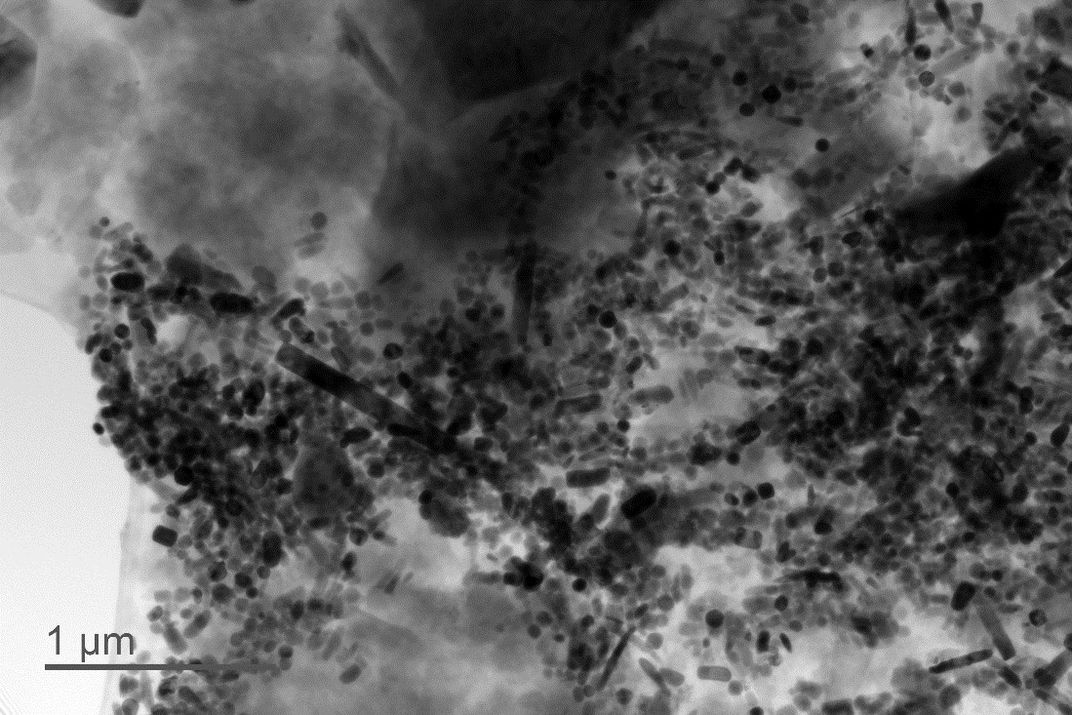NATIONAL MUSEUM OF NATURAL HISTORY
New Way to Study Magnetic Fossils Could Help Unearth Their Origins
Now that scientists can detect these fossils in geologic materials faster, they will be able to look for past evidence of the fossils more efficiently.
/https://tf-cmsv2-smithsonianmag-media.s3.amazonaws.com/blogging/featured/Magnified_black_and_white_fossil..jpg)
Deep underneath the ocean’s murky floor, there are iron bullets, needles, and spearheads. But they weren't left there by people. Instead, they are the fossilized remains of unknown organisms who lived millions of years ago through at least two extreme global warming events.
These so-called “giant” magnetofossils are impossible to see with the naked eye. Because of their size, geologists and paleobiologists used to have to study them using a labor intensive and destructive process.
Now, a team at the Smithsonian’s National Museum of Natural History, University of Utah and Central Institute of Meteorology and Geodynamics, Austria has developed a better method for studying these enigmatic, tiny specimens. Their research published today in the journal Proceedings of the National Academy of Sciences will make it easier for scientists to learn about the fossils.
“If we can find more of these magnetofossils, we can build a better picture of past environmental change, which in turn could help us anticipate future global change,” said Dr. Ioan Lascu, a research geologist and Edward and Helen Hintz Secretarial Scholar in the museum’s Department of Mineral Sciences, who co-authored the paper.
An unconventional magnetofossil
There are two types of magnetic fossils: conventional and giant. The conventional ones are one one-thousandth the width of a human hair, formed by bacteria that create iron particles to interact with Earth’s magnetic field and help them move. These “magnetotactic bacteria” still exist today and live in many different types of aquatic environments.
Giant magnetofossils, however, are so far only found in ocean sediments. They are one-hundredth the width of a human hair, making them “giant” compared to their conventional counterparts. Geologists know they were formed by living creatures because of their unique shapes.
“These fossils are crazy. Some are shaped like needles and spindles, while others look like arrowheads. One of the more common ones is probably the giant bullet,” said Courtney Wagner, a PhD candidate at the University of Utah, former Robert Hevey and Constance M. Filling Fellow in the museum’s Department of Mineral Sciences and lead author of the paper. “And because they have these shapes, when we find them in the sedimentary record, we know they’re made by some sort of organism.”

The fossils were first discovered in 2008, but scientists still don’t know what creature made them. They have since been dated to the Paleocene–Eocene Thermal Maximum (PETM) around 56 million years ago and the Mid-Eocene Climatic Optimum (MECO) roughly 40 million years ago.
Their presence in periods of environmental upheaval suggests they could be signposts in the fossil record that indicate episodes of climate change.
"Our bigger picture goal is to figure out exactly what made these fossils and why they appeared during global warming events that happen to be analogs for modern climate change,” said Wagner.
Testing fossils of unusual origin
/https://tf-cmsv2-smithsonianmag-media.s3.amazonaws.com/filer_public/12/de/12de3b39-97f2-4c7e-b75c-a098d4764e23/two_people_next_to_a_machine_in_a_lab.jpg)
Studying giant magnetofossils requires a lot of material. With the old, destructive method, that meant powdering marine sediment and imaging the powder with an electron microscope. But Wagner and her co-authors, including Dr. Ramon Egli of the Central Institute of Meteorology and Geodynamics in Austria, developed a non-destructive method that can detect needle-shaped giant magnetofossils because their shape generates a specific magnetic signature.
"We took a sediment chip about half the size of a pinky nail and put it between two really big magnets. We then applied a strong magnetic field in one direction, reversed the field direction, and repeated this a bunch of times. This, in a way, let us measure the magnetic equivalent to the physical fitness properties of the fossils in the sample," said Wagner.
The team double-checked their results by examining the fossils with the electron microscope. They then triple checked the findings by running a computer simulation of virtual needle-shaped particles in a magnetic field.
“All of our three tests — new magnetic method, classic imaging, and computer model — agreed with one another,” said Wagner.
The positives of the new method
Being able to remotely sense iron fossils in sediments will help geologists who are searching for them in samples from even older eras.
“The next step is looking for these specimens in other time periods. We mostly have found them in sediment younger than 65 million years old,” said Lascu. “Going further back in time, we really don’t know how they, or the organisms that made them, evolved.”
Now that scientists can detect these fossils in geologic materials faster, they will be able to look for past evidence of the fossils more efficiently.
“This will help advance our community a lot, because we can test multiple samples more quickly in order to learn more about the fossils” said Wagner. “It will help us figure out if the fossils are truly restricted to warming events or not.”
There's also one other question that Lascu and Wagner hope will be answered.
“Why do these exist?” said Lascu. “It's mindboggling. We still haven’t found the critters that make them.”
Related stories:
Bison Mummies Help Scientists Ruminate on Ancient Climate
Meet the Scientist Using Fossils to Predict Future Extinctions
What A 1000-Year-Old Seal Skull Can Say About Climate Change
Here's How Scientists Reconstruct Earth's Past Climates

